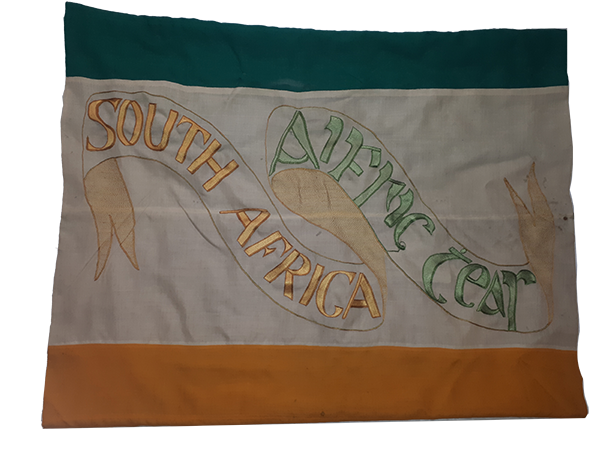FLAG OF SOUTH AFRICA FROM THE 1932 TAILTEANN GAMES
Published in Artefacts, Issue 3 (May/June 2022), Volume 30By Siobhán Doyle
According to legend, the Aonach Tailteann (Tailteann Games) was first staged in County Meath several centuries BC as a large gathering to celebrate the life of Queen Tailté, the foster-mother of Ireland’s mythical high king, Lugh of the Long Arm. There were religious, legal and matchmaking aspects to the festival, which reputedly took place every year until the time of St Patrick. Sporting and cultural events were central to the Tailteann Games, and contests included athletic, gymnastic, equestrian, dancing and storytelling events.
The revival of the Tailteann Games in the 1920s was an intentional act of state projection and self-promotion for the newly formed Irish Free State in the aftermath of revolution. The games coincided with the Summer Olympics, allowing athletes of Irish birth who participated in Paris (1924) and Amsterdam (1928) also to take part in the Tailteann Games, which were held in various venues across Ireland but centred on Croke Park. Competitions were varied and included boxing, archery and swimming, as well as literary, musical and artistic categories. With the Olympic Games being held in Los Angeles in 1932, many of the top Irish athletes had left Ireland weeks in advance and could not participate. The previous revived Tailteann Games were open to all amateur athletes of Irish birth but, owing to the scarce numbers of participants, the criteria were more lenient in 1932. These would be the last Tailteann Games.
A hurling team from South Africa competed in the 1932 Tailteann Games and also played Antrim in Corrigan Park, Belfast, where they beat the hosts with a score-line of 1–6 to 8–1. In a double header in Croke Park, they played Great Britain in a game that ended in a draw. To mark the occasion, a community of Irish nuns in Capetown designed a flag and presented it to the travelling party. The flag had a similar horizontal layout to the Prinsenweg flag of South Africa at the time, while the colours were a direct nod to the Irish tricolour. The delicate embroidery, presumably done by hand, has ‘South Africa’ in both English and Irish. The flag is on permanent display in Lár na Páirce Museum in Thurles, Co. Tipperary, and represents how the Tailteann Games gave the GAA an international character. Gaelic games continue to thrive in South Africa, with South African Gaels competing in the GAA World Games in Ireland in 2016 and 2019, this time under the new flag of their country.
This flag will feature in Siobhán Doyle’s forthcoming book, A history of the GAA in 100 objects (Merrion Press, October 2022).

















